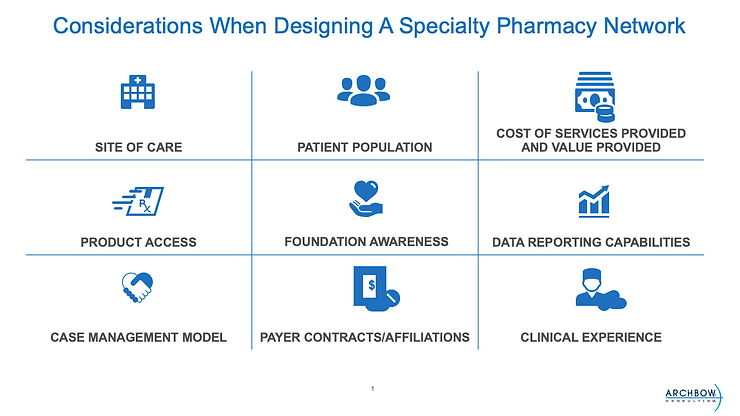9 Considerations When Designing Your Specialty Pharmacy Network
By Kristy Frizzo and Kelly Ratliff
That’s why pharma and biotech manufacturers often leverage our team’s extensive experience, along with specific decision criteria, when designing, re-designing, and/or optimizing their SP network.
- Including or excluding various dispensing entity types can have unintended consequences related to prescriber satisfaction and speed to therapy.
- Specific attention should be given to network design related to the impact of payer-owned specialty pharmacies, independent specialty pharmacies, and integrated delivery networks.
- Successful SP network strategies can be achieved by leveraging the key decision criteria detailed below. Answers to these questions should guide manufacturers to a network design that best supports patients and prescribers.
Key decision criteria for manufacturers working to maximize patient access and support specialty prescribers

- Site of Care: How and where is the product administered?
- Patient Population: What specific needs does the patient population have, and what type of pharmacy setup is required to support these needs?
- Cost Of Services Provided and Value Provided: What is the program’s cost compared to the value it provides?
- Product Access: What barriers to access are anticipated, and how will pharmacies be asked to support overcoming those barriers?
- Foundation Awareness: What ongoing research will the pharmacy need to conduct to provide patients with up-to-date foundation support options?
- Data Reporting and Technology Capabilities: What reporting and technology capabilities exist, and how do they align with manufacturer needs?
- Case Management Model: How will the pharmacy manage the program on a patient level, and will resources need to be dedicated or shared across programs?
- Payer Contracts & Affiliations: Does the pharmacy possess robust payer contract networks and/or PBM affiliations?
- Clinical Experience: What analog experience should the pharmacy have, and how specialized does the operations team need to be around a specific disease state?
These nine considerations are a reliable way to begin the conversation around SP network design. At Archbow, we start here, factor in the manufacturer’s unique goals, and then apply additional client and clinical profile criteria to ensure optimal access for patients. If your team could use additional support in designing a new network or optimizing an existing network, contact us today to get started.
Archbow Consulting helps pharmaceutical and biotech companies in the USA and Europe design, build, and optimize product distribution and patient access strategies. Archbow was founded by industry veterans to meet a need in the marketplace for consulting options that offer diverse real-world experience, are able to leverage deep connections across the industry, and can also provide actionable strategic guidance. We invite you to learn more about our team, services, and clients’ success, and connect with us via email, LinkedIn or subscribing to this blog which you can do below.
Share in
Recent Posts
Archbow Consulting Strengthens Leadership Team with Key Promotions
Strategic appointments reflect Archbow’s continued growth and commitment to delivering exceptional value to its clients.
Archbow Consulting: A Committed Partner to NASP
As the only national nonprofit organization representing all specialty pharmacy stakeholders, NASP plays a crucial role in advancing the specialty pharmacy field.
ECRM 2025: Key Trends & Opportunities
Uncovering insights in the pharmaceutical industry, including optimizing supply chain solutions and refining market access strategies.
SUBSCRIBE
Subscribe to receive news and updates from Archbow Consulting
|
|


